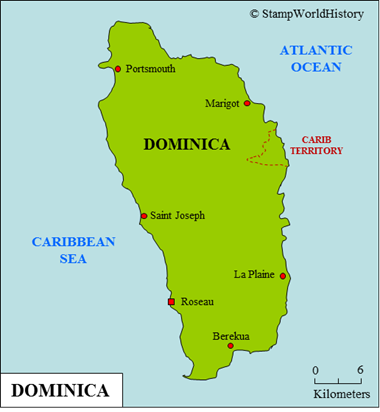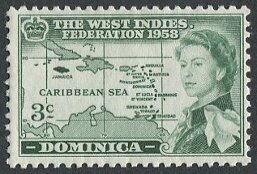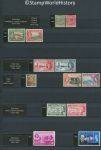
Dominica
Presidency Leeward Islands

Dominica
Colony

Dominica
Republic
Quick reference
General issues: Presidency Leeward Islands 1874-1940, British colony 1940-1958, Province West Indies Federation 1958-1962, British colony 1962-1967, Associated state 1967-1978, Republic 1978-Present
Country name on general issues: Dominica
Currency: 1 Pound = 20 Shilling, 1 Shilling = 12 Pence 1974-1949, 1 Dollar = 100 Cent 1949-Present
Population: 23 000 in 1900, 72 000 in 2016
Political history Dominica
Dominica is located in the Caribbean as one of the Lesser Antilles – for the exact location, please refer to the map of the Caribbean. Prior to colonization, Dominica was inhabited by the Amerindian Carib people – a people found on many of the Lesser Antilles. The first European to sight Dominica was Christopher Columbus in 1493. Dominica was claimed for Spain, but the Spanish did not permanently settle the island. In the 17th century Dominica was claimed by both France and Great Britain, but, as the Spanish before them, they did not actively colonize the island. In 1660, the British and the French agreed with the Caribs to leave the island to the Caribs. Nonetheless, French settlers arrived from the neighboring French colonies of Guadeloupe and Martinique, and established plantations. To man the plantations, slaves were brought from Africa. In the 18th century both France and Great Britain took a more active interest in Dominica and the island went back and forth between the two countries, until finally established as a British possession in 1805.
The colony of Dominica was, in 1833, made part of the Leeward Islands colony – the federal colony that grouped together the British possessions in the Leeward Islands. In 1871, Dominica was formally designated as a presidency of the Leeward Islands colony. Dominica was transferred from the Leeward Islands to the Windward Islands colony in 1940. Unlike the Leewards Islands, the Windward Islands colony was a loose federation, in which the constituent colonies had their own parliaments and legislation. The Windward Islands colony was dissolved in 1956. Shortly after, between 1958 and 1962, Dominica joined the West Indies Federation – a short lived federation of most of the British possessions in the Caribbean. In 1967, Dominica became self governing as an associated state and, in 1978, Dominica gained full independence as a parliamentary republic – officially named the Commonwealth of Dominica. Dominica has remained a member of the British Commonwealth.
Economically, agriculture is the most important sector – bananas being the most important crop. In recent years, the government has sought to diversify the economy, developing tourism and off shore financial services. Although ranked as a High Development Country on the United Nations Human Development Index, Dominica is one of the less developed countries in the Lesser Antilles. The majority of the population is black – 86%. In the Lesser Antilles, Dominica, until today, has a distinctive indigenous population. The Caribs account for 3% of the population and have been awarded a reserve – the Carib Territory – in which they enjoy a certain amount of self government.
Postal history Dominica
The first stamps used in Dominica were the general issues of Great Britain. These were used between 1858 and 1860. Dominica issued its first stamps in 1874. This issue, and subsequent issues until 1890, are of the same design, showing the portrait of Queen Victoria. Between 1890 and 1903 the issues of the Leeward Islands were used exclusively. Dominica resumed issuing stamps in 1903 – these were used concurrent with the issues of the Leeward Islands until 1940. In the classical period, Dominica issued relatively few stamps – some of designs specific for Dominica and some of designs common to the British colonies. Dominica joined in a number of the omnibus issues for the British colonies. In the modern era, Dominica, as an associated state, issued stamps mainly with designs of national interest. After independence, Dominica has issued large numbers of stamps, primarily aimed at the thematic collectors market.
Album pages
← Previous page: Danish West IndiesNext page: Dominican Republic →





